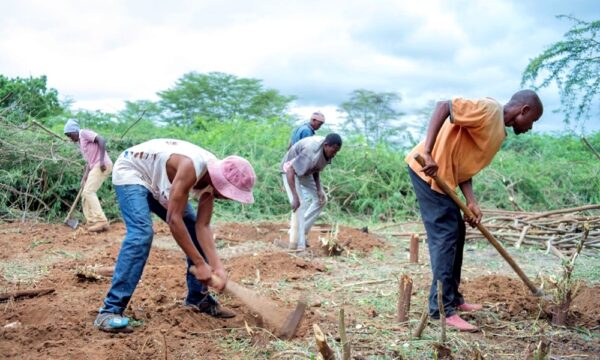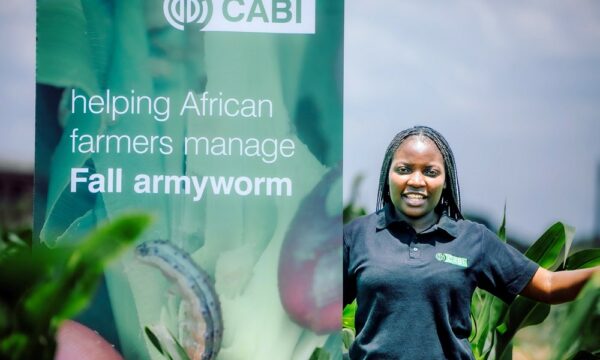The CABI journal CAB Reviews has just published its 1000th paper, with a study examining how smallholder farmers can manage the devastating crop pest fall armyworm (FAW, Spodoptera frugiperda). The rapid spread of the FAW to sub-Saharan Africa and Asia is a major threat to smallholder maize farmers, with an average infestation level of 30% of plants across Africa (see CABI’s Fall Armyworm Portal).

In his article, Allan Hruska of the Food and Agriculture Organization has examined published studies to see which management options are most likely to work for smallholders. The practicalities are very different from management approaches for large-scale maize production, especially as practiced in the USA. Studies suggest that on small plots, mechanical control by squashing egg masses and handpicking small larvae is effective (FAO, 2018). Push-pull systems, involving a plant, such as desmodium, that repels insects, and another, such as Napier grass, that attracts them, have reduced FAW infestations and damage (Midega, 2018). Other tactics such as intercropping with pumpkin, common beans or groundnut are useful against FAW. Intercropping can increase the levels of natural enemies that attack FAW.
Researchers have used botanical extracts from neem, eucalyptus and Mexican marigold against FAW. A swamp smartweed extract killed as many FAW larvae as a commercial insecticide. “I’m quite optimistic about the quick uptake of locally-available botanical insecticides, including neem, says Hruska. “We have data that simple extractions from leaves of neem and other locally-available plants kill FAW.”
Some farmers place soil into the infested whorls of maize plants, and research suggests a combination of the physical characteristics of the soil and its content of pathogens of insects such as Bacillus thuringiensis (Bt) and S. frugiperda nucleopolyhedrovirus (SfNPV) can help control FAW. “Soil is very interesting,” says Hruska, “as it can kill young FAW larvae directly through physical contact (abrasion of cuticle leading to desiccation) and even more interesting is the microbial community it may contain, including FAW pathogens, including Bt, SfNPV, and fungi. These characteristics of the soil are obviously also location-specific.” Sand, ash and soil are widely used, but their effectiveness still needs scientific evidence, he says.
While techniques such as genetic modification and chemical control are not accessible to smallholder farmers, the use of biological control, plant chemical ecology and locally available substances offer potential. However, large knowledge gaps exist about them, and “very little research is being carried out on the use of these methods by smallholders”, says Hruska. Research done on smallholder practices in Central America and Mexico in relation to FAW could be relevant to smallholders in Africa. He says that some ideas, such as the use of fish soup to attract ants to fields, are being tried in Malawi. What is needed for researchers to work with farmer innovators to examine which techniques work, and what the costs are in terms of finance and labour.
The use of plant diversity to decrease FAW egg laying and increase natural enemies has also been shown to function many times, says Hruska, “but farmer uptake has not been as fast as hoped.” He says “the conservation, attraction, and “re-cycling” of pathogens does work, but there’s a bit of a learning curve to get farmers to do them. “Re-cycling” of pathogens has been shown to be locally used (especially in India with other Spodoptera species). Very simple collection, simple extraction of the microbes, and re-application into the field is very promising in those areas where there is enough naturally-occurring mortality.”
In addition to this recycling approach, Hruska says there is potential for biocontrol can be used with smallholders in several ways. One way is simply allowing natural enemy populations to build and become effective. “This can be achieved by reducing pesticide sprays and maintaining plant diversity, which provides food and shelter for the beneficial organisms.” Local production and use of biocontrol agents in an augmentative way is an option, as the egg parasitoid Trichogramma can be easily massed produced and prepared for liberation.
Hruska says that there are a number of ongoing trials of biological control. CABI is doing a number of them, both in Africa and in the joint China-CABI lab. “FAO is funding work in three locations in Africa, with our partners IITA, icipie and the Northwest University of South Africa. Norway is generously funding this work.”
CAB Reviews is a peer-reviewed journal covering agriculture, animal science, applied plant sciences, global health, veterinary medicine, nutrition and food science, natural resources and environmental sciences. To find out more, contact the editor Dr David Hemming d.hemming@cabi.org.
Hruska, A. J. (2019) Fall armyworm (Spodoptera frugiperda) management by smallholders. CAB Reviews 14, No. 043.
This open access article is available for download here
Related News & Blogs
Biosecurity and skills development workshop brings together key players in Africa’s plant health ecosystem
CABI has convened a plant biosecurity training and skills development workshop bringing together key players in Africa’s plant health ecosystem keen to help the continent’s smallholder farmers improve their livelihoods and food security. The workshop w…
23 June 2025




